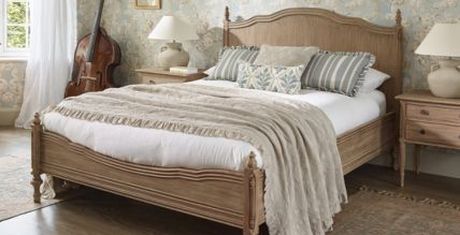The Origin
Rattan has always been a popular material. Buried with pharaohs in ancient Egypt, used for basket weaving, and later commandeered by the Romans to create rattan furniture, rattan has always been a wonderfully durable, natural, and sustainable choice for furniture.
But with such intricate designs, a truly unique composition of material, and with so much misinformation around synthetic and natural rattan furniture, we wanted to clear up how rattan furniture is made and explain the painstaking process of how rattan is harvested and manipulated into the iconic weave that it is known for.
Love Story Sérénité Rattan Bed
Deriving from a natural climbing palm plant or vine-like species, which is native to Southeast Asia, as well as other tropical countries, rattan is a fast growing and diverse plant which have been known to grow up to 30 metres in length, and sometimes even taller. Rattan is much easier to harvest, requires simpler tools, and is much easier to transport than most other tropical woods, making it a preferred material in the fight against deforestation and a beacon of hope in the shift towards slow and sustainable furniture.
However, rattan harvesters are highly skilled, using a machete to break apart the rattan from up high and ensuring to only harvest the best rattan vines which are fully ripe, undamaged, and mature enough to be made into a strong and flexible material, perfect for weaving into baskets, furniture, bowls, and more.
The Process
Cutting plant – After a mature and ripe rattan plant has been harvested, the first step is to soak it for a period to ensure the outer layer is easier to peel away, revealing the rich and malleable rattan interior. The outer layer of bark is used to make cane, which you can read more about in our blog "The Charm of Wicker and Cane in Bedroom Furniture". The interior of the rattan plant is the pure and raw form of rattan. In this way, there is little wastage in harvesting and using rattan to produce furniture.
Curing plant – Once the harvested rattan is passed onto producers for weaving, the plant goes through a process to prepare it for weaving. This can include washing, steaming, curing, and treating the plant, ensuring no leaf is left unturned. The rattan is then left to dry in the sun, giving the rattan the golden honey colour that it is so well known and loved for.
After this, the raw material is carefully and lovingly handwoven to take the necessary shape for the furniture it will become!

The Finished Product
Normandy Rattan Painted Luxury French Bed
We love the old-fashioned elegance of this hand carved mahogany luxury bed. The frame is finished in a lightly distressed pale stone colour, with natural rattan and a very gently curved footboard.
Fringed Rattan Pendant Light in Natural
The rattan core is steamed and sliced to make different shapes for the furniture. Rattan is most commonly treated and painted, while the cane is left in its natural round state. In terms of strength, the cane is generally more durable than rattan, which is why it's often used for binding purposes. Cane is traditionally woven into different webbed patterns. The rule of thumb is that pieces that feature thin, woven accents, like at the back of a chair or on a cabinet door, are considered cane.


















